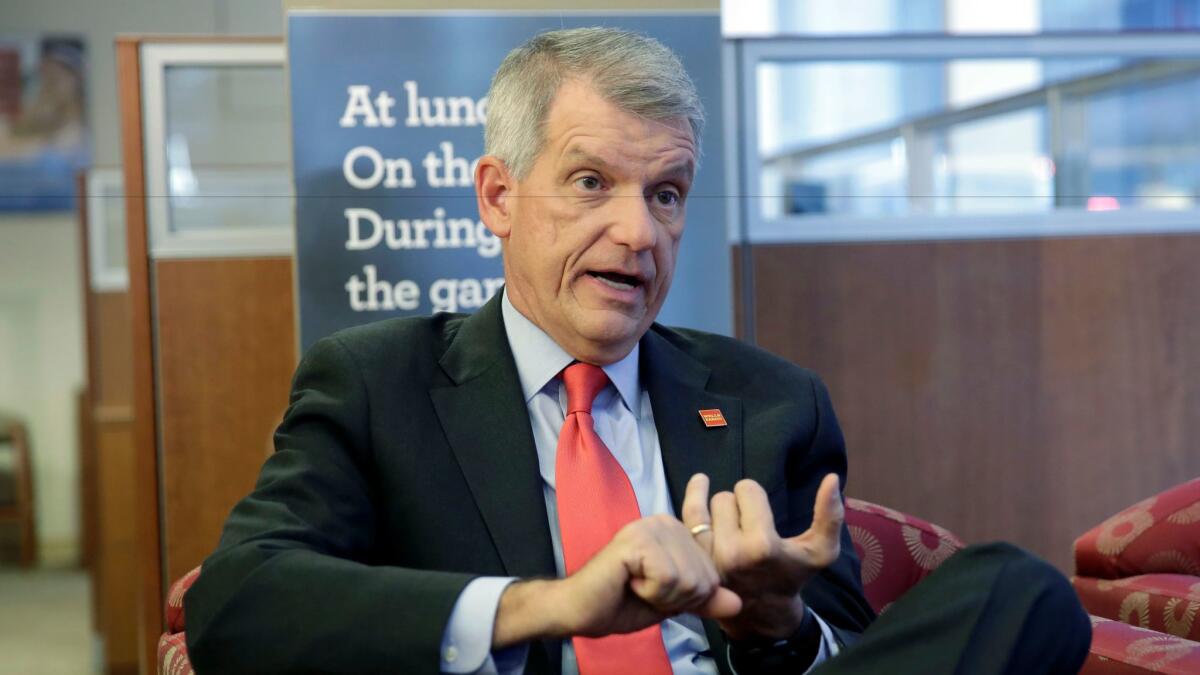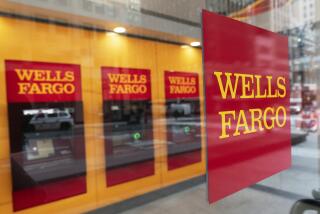Column: Here’s why Wells Fargo forces its customers into arbitration: It wins most of the time

- Share via
The insistence by Wells Fargo that the victims of its bogus account-opening scandal seek redress via arbitration, rather than in court, remains the best indication that the bank’s promise to “make things right” for those customers is fake.
We’ve pointed out before that big companies like Wells Fargo love to force customers into arbitration because the companies are heavily favored in the process. They’re repeat players, so they have familiarity with the system. They can stick customers with half the cost of arbitration, even if the customers win, increasing the customers’ risk. And they can bar customers from filing class actions, which for a corporation is a big plus.
A new study shows just how advantageous arbitration has been for Wells Fargo. Short answer: For the bank, it’s been great.
The Wells Fargo situation illustrates exactly what is wrong with contemporary arbitration law.
— David Horton, UC Davis School of Law
The study comes from Level Playing Field, an Arizona nonprofit that maintains a database of arbitration awards. The group mined records of 215 cases filed against Wells Fargo in 2009-2016 for its report. Its core finding is that of 48 consumer-initiated arbitration cases that resulted in a financial award, consumers won a documented victory in only seven, collecting a total of $349,549. The bank prevailed in 13 cases, collecting $485,208. Records for the other 28 cases don’t identify a winner, but in those cases Wells Fargo was awarded $519,458 by the arbitrators, while the consumers received only $82,527.
Those figures reflect the “improbable chance that consumers will be compensated wholly or at all” in arbitration, says Matthew Waldron of UC’s Hastings School of Law, who has analyzed statistics of arbitration cases involving Wells Fargo and other banks. The Level Playing Field report notes that plaintiffs prevail in more than 60% in state court contract cases that go to trial, but won only 35% in the Wells Fargo cases — seven out of 20 — in which the victor was identified in the arbitration record. Wells Fargo declined to comment on the report.
The Level Playing Field database implies that arbitration cases against Wells Fargo surged in 2015 and 2016. That’s especially true in California, where 58 cases were closed in those two years, compared to 33 over the previous six years. That may reflect spreading awareness of the account-opening scandal, which was first exposed by The Times in 2013.
Arbitration statistics have their limitations, but those just explain further why forced arbitration tends to be anti-consumer. Unlike lawsuits, the cases aren’t public, so they yield almost no information about the nature of the customer complaints or their magnitude. It’s possible, for example, that banks settle cases they believe will go against them, and pursue to the end only cases they feel they’re likely to win. Of the 215 cases in the report database, 119 were settled before they reached an arbitrator, 25 were withdrawn by the plaintiff and 23 were dropped for other reasons. The absence of a public record may have allowed the Wells Fargo scandal to persist for years out of public view.
The results shed additional light on the bank’s approach to making up for its scandal, in which retail bankers met crushing sales quotas by opening as many as 2 million bogus checking and credit card accounts in the names of bank customers. Wells Fargo settled charges from federal and state regulators last year for $185 million and thus far has refunded $3.2 million for 130,000 presumably fake accounts. That averages out to $24.61 per account, so you’re welcome to judge whether it’s enough to “make things right.”
Wells Fargo says it’s still working to figure out “the best way” to compensate customers whose credit standing may have been harmed by the fake accounts. But so far, its PR efforts seem to have made much more progress. Just this week, the bank placed full-page ads in about 30 newspapers nationwide crowing about its “progress.” The ads said that Wells has “strengthened our ethics … and we’ve demanded greater accountability from ourselves.”
That’s nice to know, but it’s window dressing as long as many of the people who were in positions of responsibility during the scandal period, which may have lasted from 2009 through 2015 or longer, remain in office. That includes 12 of the bank’s 15 current board members, including Chairman Stephen Sanger.
Indeed, as my colleague James Rufus Koren reports, the influential shareholder advisory firm Institutional Shareholder Services recommended Friday that those directors, some of whom have been collecting dust around the board table since the 1990s, all be voted off the board at the bank’s annual meeting on April 25. We would advocate dumping them all and going even further, barring them from serving any public company as a director or officer ever again. If “demanding greater accountability” means anything, the company should claw back the more than $20 million they collected during the scandal era, too; plainly they didn’t earn the money.
Wells Fargo’s policy of forcing aggrieved customers into arbitration has benefited the bank in other ways, beyond reducing its risk of payouts.
“The Wells Fargo situation illustrates exactly what is wrong with contemporary arbitration law,” says David Horton, an arbitration expert at UC Davis law school. Arbitration clauses typically are buried within account agreements, where customers’ eyes skate over them. The Wells Fargo clause covers not only the specific accounts being opened, but almost any disputes with the bank, even those involving “broken promises … or other wrongful actions.”
Especially egregious, Horton says, are clauses in the Wells Fargo agreement and others that forbid customers to file class-action lawsuits or to band together with other customers in class actions in arbitration.
“There’s no question that requiring customers to pursue their claims individually means that fewer claims are brought,” Horton says, “and companies like Wells Fargo aren’t deterred from violating the law.”
Keep up to date with Michael Hiltzik. Follow @hiltzikm on Twitter, see his Facebook page, or email [email protected].
Return to Michael Hiltzik’s blog.
UPDATES:
9:08 a.m., April 8: This post has been updated to clarify that Wells Fargo’s $3.2 million in refunds covered 130,000 accounts, not customers. The bank has not disclosed the number of customers affected.
More to Read
Inside the business of entertainment
The Wide Shot brings you news, analysis and insights on everything from streaming wars to production — and what it all means for the future.
You may occasionally receive promotional content from the Los Angeles Times.











